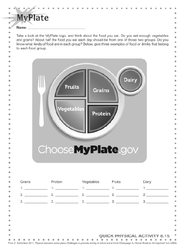Activity 8.15 MyPlate
 NASPE Standards
NASPE Standards
5, 6
Skills
In this activity, students demonstrate the following skills:
- Social and self-awareness
- Fitness (general)
Directions
Students fill in the blanks at the bottom of the worksheet with examples from the food groups: grains, vegetables, fruits, dairy, and protein. Students will provide three examples of food or drinks that belong in each food group.
Because many students will not have any clue at first about how foods are categorized, give an example of a food in each food group.
- Grains: bread
- Vegetables: green beans
- Fruits: apple
- Dairy: milk
- Protein: chicken
Activity 8.16 Goal Setting
NASPE Standards
5, 6
Skills
In this activity, students demonstrate the following skills:
- Social and self-awareness
- Other (goal setting, perseverance)
Directions
Explain the importance of setting goals. The students then fill in the blanks with what they would like to reach for. Goal setting is a skill that they can learn early to help them accomplish tasks and get to where they would like to be. Explain how personal goals are like soccer goals. Students may want to score a goal, but they must figure out a way to get the ball all the way down the field and into the net with all the defenders trying to stop them. They need to plan, strategize, and keep trying over and over to meet their personal goals.
Answer the questions yourself first, and share your responses with the students.

Activity 8.17 Active Land Game

NASPE Standards
1, 2, 5, 6
Skills
In this activity, students demonstrate the following skills:
- Fitness (general)
- Agility
- Strength
- Flexibility
- Endurance
- Movement
Directions
You’ll need a penny to determine how students move forward in this game; tails is worth two spots on the board and heads is worth one spot (dice can be used also: evens move two spots; odds move one). Two students attempt to get to the finish line by performing the actions on the board. If a student does not perform an action correctly, his or her partner can disapprove the move, which prevents the person from moving forward. The game relies on luck and effort, but students will have total fitness awareness and a workout by the time they finish.
Activity 8.18 Dot Box

NASPE Standard
1
Skills
In this activity, students demonstrate the following skills:
Directions
Working in pairs, students take turns connecting the dots, one line at a time, in an attempt to form a square. When a square is completed, the student writes his or her first initial inside the square to claim it and then takes another turn. After claiming a square, the victor must perform an exercise. Make them building Xs in which you determine the exercise (write it on the board or say it); the number of repetitions students perform corresponds to the number of boxes they have claimed.
Activity 8.19 Hmmmmm . . . True or Crazy?

NASPE Standard
6
Skills
In this activity, students demonstrate the following skills:
- Social and self-awareness
- Fitness (general)
Directions
Ask the students to decide whether each of the following statements is true or crazy. Have them circle their answers and do building Xs for each correct answer.
- Football players in the 1930s had to wear skirts when playing in Texas. (Crazy!)
- Two 11-year-olds hold the record for the longest tennis point ever played; it was 51 1/2 minutes. (True!)
- The Jamaican bobsled team qualified for the 1988 Olympics but didn’t train in the snow or ice. (True!)
- Weightlifters have to weigh at least 300 pounds (136 kg). (Crazy!)
- In 1999, Pete Sampras hit a tennis ball so hard that it went right through his opponent’s racket. (True!)
- Bartolo Colon, in baseball, once threw 20 pitches before he finally got the batter out. (True!)
- Softball was introduced in 1947 and was played with a 12-inch (30.5 cm) golf ball. (Crazy!)
- Basketball was invented to occupy students between football and baseball season. (True!)
- The moonwalk is a dance made famous by Michael Jackson. (True!)
- In 1971, Alan Shepard hit a golf ball on the moon. (True!)
- The Iditarod is a cat race in which contestants eat mush. (Crazy!)
- The Fosbury Flop is a method of high jumping. (True!)